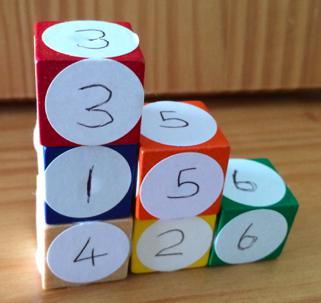Skip over navigation

The shape we make has to be only one cube thick. The shape on the left is built correctly, but the shape on the right would not be allowed as it is two bricks thick in places.
The total of the shape on the left is 70. Can you see why?
Start by making a staircase shape. An example is shown below:

a) What is the highest total you can make by using this staircase shape?
b) What is the lowest total you can make by using this staircase shape?
c) How did you calculate the totals for a) and b) above? Why did you choose the method(s) that you did?
d) Have a go at making a total of 75 using a staircase shape.
CHALLENGE 2



Or search by topic
Number and algebra
Geometry and measure
Probability and statistics
Working mathematically
Advanced mathematics
For younger learners
Six Numbered Cubes
Age 7 to 11
Challenge Level 





The aim of this challenge is to find the total of all the visible numbers on the cubes.
We are using six cubes. Each cube has six faces of the same number.
We are using six cubes. Each cube has six faces of the same number.

The shape we make has to be only one cube thick. The shape on the left is built correctly, but the shape on the right would not be allowed as it is two bricks thick in places.
The total of the shape on the left is 70. Can you see why?
CHALLENGE 1
Start by making a staircase shape. An example is shown below:

a) What is the highest total you can make by using this staircase shape?
b) What is the lowest total you can make by using this staircase shape?
c) How did you calculate the totals for a) and b) above? Why did you choose the method(s) that you did?
d) Have a go at making a total of 75 using a staircase shape.
CHALLENGE 2
Using any shape of single cube thickness, what is the lowest total you can make?
How can you be sure this is the lowest total whatever the shape?
Can the lowest total be found in more than one way? Justify your answer.
How can you be sure this is the lowest total whatever the shape?
Can the lowest total be found in more than one way? Justify your answer.
CHALLENGE 3
Using any shape of single cube thickness, what is the highest total you can make?
How can you be sure this is the highest total whatever the shape?
Can the highest total be found in more than one way? Justify your answer.
How can you be sure this is the highest total whatever the shape?
Can the highest total be found in more than one way? Justify your answer.
CHALLENGE 4
Prove the following by logical reasoning, rather than by calculating the answers:
If the cubes are arranged in a single vertical tower (like this)

then no matter what order the cubes are in, the total cannot be 80.
This problem featured in a round of the Young Mathematicians' Award 2014.
If the cubes are arranged in a single vertical tower (like this)

then no matter what order the cubes are in, the total cannot be 80.
This problem featured in a round of the Young Mathematicians' Award 2014.
You may also like
Pebbles
Place four pebbles on the sand in the form of a square. Keep adding as few pebbles as necessary to double the area. How many extra pebbles are added each time?
Bracelets
Investigate the different shaped bracelets you could make from 18 different spherical beads. How do they compare if you use 24 beads?
Sweets in a Box
How many different shaped boxes can you design for 36 sweets in one layer? Can you arrange the sweets so that no sweets of the same colour are next to each other in any direction?

